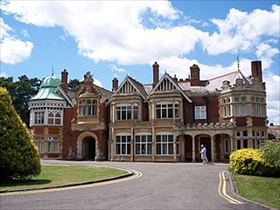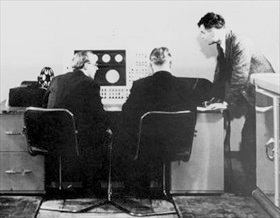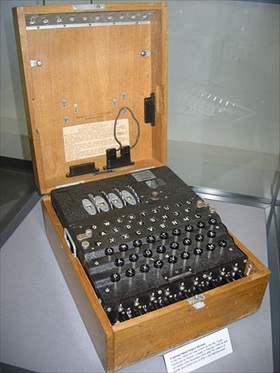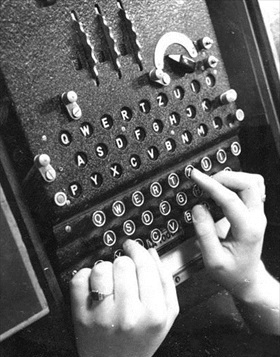BRITISH USE ENIGMA MESSAGES TO DEFEAT ROMMEL
London, England • January 21, 1943
Arguably one of Germany’s greatest assets early in World War II was the Enigma machine. It could encrypt and decrypt sensitive diplomatic and military messages in billions of ways (actually 10 to the 23rd power). The location of German surface ships and U‑boats and Allied supply convoys in the Atlantic theater as also German orders of battle were sent and received on Nazi Enigma machines.
On this date, January 21, 1943, in Italy’s North African colony of Libya, British commander Bernard Law Montgomery, using Ultra intercepts (the codename for the secret Enigma messages), changed his plans to attack German Field Marshal Erwin Rommel’s Afrika Korps. He ordered the drive on the Libyan capital, Tripoli, be directed along the coastal road rather than to the south as planned. Two days later a confident British Eighth Army entered Tripoli. Rommel’s last assault on the Eighth Army—indeed his last offensive in North Africa—initiated on March 6, 1943, was turned back based on Ultra intercepts. Looking for a scapegoat, Rommel attributed his battlefield failures as well as heavy losses in relief supplies being ferried by sea and air across the Mediterranean to leaks by senior Italians on his staff.
The Ultra intelligence used by Montgomery was produced on machines that somewhat resembled ordinary typewriters but were actually electromechanical devices that encoded and decoded German high-frequency radio Morse code and teletype traffic using pre-set alphabetical rotating wheels, or rotors. The continual movement of the interchangeable rotors (three, after February 1942 four rotors used by the German Kriegsmarine) resulted in a different cryptographic substitution after each typewriter key was pressed, scrambling sentences into illogical sequences of letters.
Following pioneering Polish work in the 1930s on German commercial encryption devices called “Enigmas,” British codebreakers in Bletchley Park 50 miles north-northwest of London deciphered the Enigma code in 1941 (the Poles hadn’t been able to). The Germans believed the Enigma code was unbreakable, but the British team of mathematicians, linguists, scientists, classical musicians, card-counting poker players, crossword puzzle enthusiasts and others with an aptitude for encoding and decoding methodically honed in on several design flaws, one being that Enigma could not encrypt any letter as itself—that is, “E” could never become “E.” Also, Enigma had a reciprocal quality in that if “E” became “G” on a certain cipher key setting, then “G” became “E.”
The capture of German encryption materials from German naval vessels (e.g., three Enigma wheels in February 1940; a working Enigma cipher machine, cipher tables, and signal books in May 1941 and again in October and September 1942 following the introduction of the naval four-rotor Enigma machine) gave the Bletchley team additional help. So did the advantage gained by exploiting certain German slipshod procedures; e.g., cipher clerks neglecting to select a new cipher key for each new radio message but simply using the day’s initial settings to save time. Though the Bletchley operation was only disclosed to the public in 1974, historians since have generally concluded that the intelligence gained from the Ultra breakthrough shortened the war by two or more years. Gen. Dwight D. Eisenhower, Supreme Commander of Allied Forces, acknowledged in July 1945 that the Bletchley Park workforce “saved thousands of British and American lives and, in no small way, contributed to the speed with which the enemy was routed.”
![]()
Bletchley Park: Unraveling the Secrets of the Enigma Cipher Machine
 |  |
Left: Midway between the university towns of Oxford and Cambridge, Bletchley Park was the top-secret headquarters of Britain’s Government Code and Cypher School. It was at this Buckinghamshire country estate that ciphers and codes of several Axis countries were decrypted and forwarded to various Allied military headquarters and intelligence centers (e.g., the Royal Navy’s Operational Intelligence Center) to help in prosecuting the war. Bletchley Park’s mock-Tudor mansion, with its surrounding buildings (called “huts”), was home to as many as 10,000 men and women during the war years, including Britain’s most brilliant mathematical brains, and was the scene of immense advances in computer science and modern programmable electronic computing. Materially assisting Bletchley Park’s activities from 1943 onward were American-designed and -built high-speed, high-powered computing machines located in Dayton, Ohio. British Prime Minister Winston Churchill referred to the Bletchley staff as “the geese that laid the golden eggs and never cackled.”
![]()
Right: Widely considered to be the father of computer science and artificial intelligence, Alan Turing (standing) was a nerdy, soft-spoken Cambridge mathematician and wartime codebreaker. At Bletchley Park, Turing (1912–1954), nicknamed “Prof” by his colleagues, and another of Britain’s top codebreakers, Gordon Welchman (1906–1985), teamed up to design an electromechanical machine known as a “bombe” (a Polish word for a type of ice-cream dessert) that could scan and, applying mathematical logic, analyze and decrypt the huge amount of Enigma signal traffic generated by the Nazi war machine and sent over high-frequency circuits. The British built 60 bombe machines. The original machine was 7 ft tall by 6-1/2 ft wide and could drive through every potential Enigma setting in about 12 minutes by electrically performing a chain of logical deductions that provided codebreakers with a small number of possible Enigma settings. By the end of the war, 9,000 people were operating these machines to process thousands of intelligence intercepts every day. The commercially and critically successful 2014 film The Imitation Game, starring Benedict Cumberbatch, is loosely based on the role Turing and his cryptanalysts played in solving the Enigma code.
 |  |
Left: On display at Bletchley Park is a four-rotor German naval Enigma, which compared with the three-rotor Enigma machine created twenty-six more ways to encipher each letter of the German alphabet. To encrypt or decrypt a message, an operator inserted the rotors into the Enigma machine and positioned them in a certain order, as specified by a multi-letter cipher key. Each rotor could be set in twenty-six different positions, and each rotor—they were many to chose from—had an arrangement of internal wiring unique to itself. The rotors were surrounded by movable outer rings. Additionally there were electrical plugs, called “steckers,” attached by jumper cables to a plugboard. Jumper cable settings on the plugboard (front of machine, partially hidden in this photo), in combination with rotor and ring settings, determined the code when a single letter was typed. Because all three components worked independently of one another, billions of combinations were possible, and these billions of combinations changed daily based on the setting order (cipher key) for the spinning rotors and other movable parts. With each keystroke creating an electrical path through this programmable maze of hardware wiring, the corresponding coded (or decoded) letter lighted up on the output panel above the keyboard, allowing the operator or an assistant to transcribe the secret message. The British-captured cryptographic prize in late October 1942 of equipment along with a weather cipher book giving current key settings was crucially important in breaking German U‑boat codes and ultimately in winning the Battle of the Atlantic.
![]()
Right: A three-rotor Enigma ciphering machine in use by the Luftwaffe, German Army (Heer), and shore weather stations, December 1943. An estimated 100,000 Enigma machines were constructed during the war and used principally by the three German armed services, the third being the Kriegsmarine. Almost to the end of the war, Germans had firm faith in the Enigma machine. Indeed, Adm. Karl Doenitz had been advised that a cryptanalytic attack on his navy’s Enigma machines was the least likely of all his security problems. But the truth was that by 1942 Allied codebreakers were deciphering nearly 4,000 German transmissions daily, reaping a wealth of information used by the British and Americans against German land, air, and naval forces.
Scholarly Explanation of Encryption Technology: How Enigma Machine Worked and How the German Code Was Cracked
![]()

 History buffs, there is good news! The Daily Chronicles of World War II is now available as an ebook for $4.99 on Amazon.com. Containing a year’s worth of dated entries from this website, the ebook brings the story of this tumultuous era to life in a compelling, authoritative, and succinct manner. Featuring inventive navigation aids, the ebook enables readers to instantly move forward or backward by month and date to different dated entries. Simple and elegant! Click
History buffs, there is good news! The Daily Chronicles of World War II is now available as an ebook for $4.99 on Amazon.com. Containing a year’s worth of dated entries from this website, the ebook brings the story of this tumultuous era to life in a compelling, authoritative, and succinct manner. Featuring inventive navigation aids, the ebook enables readers to instantly move forward or backward by month and date to different dated entries. Simple and elegant! Click 











